Enriching the Learning Environment at the Cégep de Granby with ALCs
In her Real Life Story entitled Apprendre et surprendre grâce à la CLAAC, Nicole Lanctôt, a teacher from the Cégep de Granby presents her active learning projects that are happening in a brand new Active Learning Classroom (ALC) designed for this type of pedagogy. In the present article, I will explain how we arrived at this point as a college, touching on the consultation and analysis process, the pedagogical reflections, our vision for the development of our milieu and the choices linked to the installation and renovation of 2 classrooms over the summer of 2017:
- The first of which we have dubbed the “Royal ALC of Distinction,” (but since Ms. Lanctôt requested the room with so much perseverance and conviction, we could have simply called it “Nicole’s Class”).
- The other is an ALC adapted to a DCS/DEC in Tourism where students bring their own mobile devices.
The beginning of the dream that became a reality
As is the case with many colleges, our classrooms that are designed for active learning and collaborative work emerged from the field. We needed to respond to the pedagogical needs that were being expressed by the teachers. In April 2014, as part of a pedagogical reflection exercise that was organized for members of our ICT committee, we established a vision for the future of the ICT environment. Among the 12 orientations identified were the active learning concept and the notion of configuring multi-purpose spaces (flexible and multidisciplinary).
During this same period, a new observation space was configured for the Early Childhood Education program. This class is, without a doubt, the first ALC – with tables on wheels, a variety of colourful chairs, original footstools, comfortable cushions and a carpet that fosters floor-based activities. In Early Childhood Education, not only are we exposing our students to active learning, but we are teaching faculty so that the children will also have this experience.
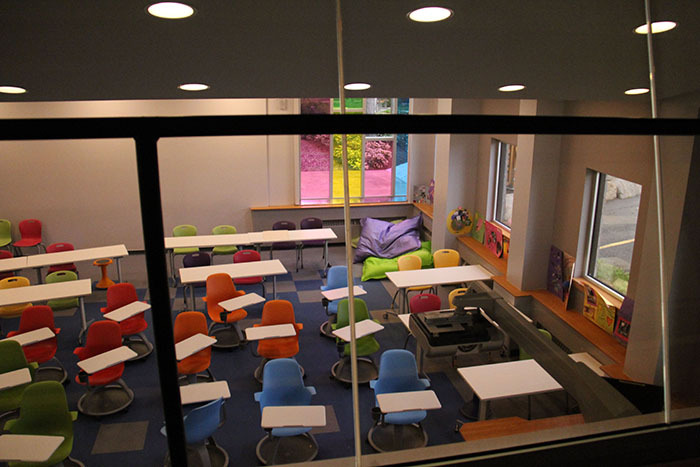
The B128 ALC: Early Childhood Education observation lab
In 2016-2017, we benefited from a major nursing facilities refurbishment project and the dismantling of a computer lab following the decision to move to a Bring Your Own Device (BYOD) approach in Tourism which resulted in the implementation of 2 new ALCs. To my immense pleasure, I was tasked with the responsibility to develop this wonderful project.
A collaborative project from start to finish
My first step was to form a multidisciplinary team comprised of 7 teachers from 5 disciplines that had concretely demonstrated their interest for ALC spaces in the last few years:
- Industrial Engineering
- Nursing
- Early Childhood Education
- Special Education
- Philosophy
The objective for the project was to improve classrooms at the Cégep de Granby in order to promote active learning and teamwork by developing a short- and long-term vision for the future. Parallel to this, I collaborated with teachers from the Tourism department to define the orientations for the classrooms (which will primarily be used by this program) and ensured that the approaches for each of the projects were aligned.
We designed a survey entitled Let’s dream about our ideal classrooms together (Rêvons ensemble nos salles de classe idéales) to measure where the community was at, gauge the interest and teachers preferences for active learning and group work in order to identify the essential features and characteristics for the spaces that would support the pedagogical activities the teachers were advocating. We should mention that we drew on the expertise of a an ALC research group with special thanks to Samuel Fournier St-Laurent, a Pedagogical counsellor in research and innovation from the Collège Ahuntsic whose cooperation was appreciated.
Among the most important characteristics and functions that were highlighted as part of our consultation, were included:
- Have one table for each team
- Ensure that devices can easily be plugged in
- Be able to write on the wall and also post things on the wall
- Ensure that students can easily connect their devices to projectors and sound
- Lighting and space
- Flexibility to rearrange (but a certain number of teachers still prefer furniture that is fixed in place)
- Take notes on surfaces, share images
Here are the types of team-based pedagogical activities that can be done within the classroom that received a rating of “very interesting” by greater than 50% of the survey respondents:
- Problem-solving, case studies, theoretical or practical exercises
- Discussions, negotiations, debates, panel discussions, round-table discussions
- Simulations, role-playing
- Brainstorming
- Applied labs
- Presentations, orals, demonstrations
- Games, tournaments, competitions, riddles
Processing information using visualization (diagrams, tables) and searching for information also generated a lot of interest (48% and 47% respectively).
Even though all of these activities can be done with paper or other manual methods, technologies undoubtedly provide fertile ground for supporting these types of activities. The ICT Profile skills for college students are certainly relevant and called into use!
We also identified and analyzed ALC projects occurring throughout the college network, notably through our exchanges within the IT-Representatives’ Network (REPTICs). We also visited 5 colleges, who graciously and generously agreed to share their experience with us in the spirit of cooperation:
- Édouard-Montpetit
- Dawson
- Montmorency
- Ahuntsic
- Rosemont
Here are the favourite discoveries from our grand tour of the colleges:
- The wall-to-wall whiteboards, small custom tables, chairs with baskets underneath, wireless projectors and the absence of a designated spot for the teacher in the classroom at Montmorency.
- The use of team-specific colours of furniture or on the walls to identify teams at Dawson and Ahuntsic.
- The table design at Dawson that emerged from an ergonomic audit and a flower-type configuration of one of the classrooms that permits a 360-degree view of teams and posted content.
- The quality of the lighting and acoustics, space, projection systems and the distinctive style at Ahuntsic.
- Floors that were drilled with holes to manage cables and wires at Édouard-Montpetit and Ahuntsic (they’re so lucky!).
- The television and broadcast tools at Édouard-Montpetit.
- The 6 tables with 6 places at Rosemont, our operational ideal (36 spots and facilitated organization of teams with 2-3-6 students).
- The 12 dedicated laptops at Rosemont.
These steps really helped us to weigh the different options that were available to us in terms of refurbishing our classrooms, the choice of furniture and which technologies that we should select based on our specific needs.
The space influences both the learning and the teaching. The teachers plan their learning activities based on the environments they will have access to. To foster pedagogical innovation, it’s important to offer them an environment that lends itself to a variety of pedagogical methods, to collaboration and to creativity.
Here are the key points that best define our vision with regards to the essential features for our future active learning classrooms:
- The collaboration and interaction they will allow
- The variety, the flexibility and the adaptiveness they confer
- The space and the mobility that they offer
- The functional nature of their components
- Their inspiring, creative, stimulating and distinctive style
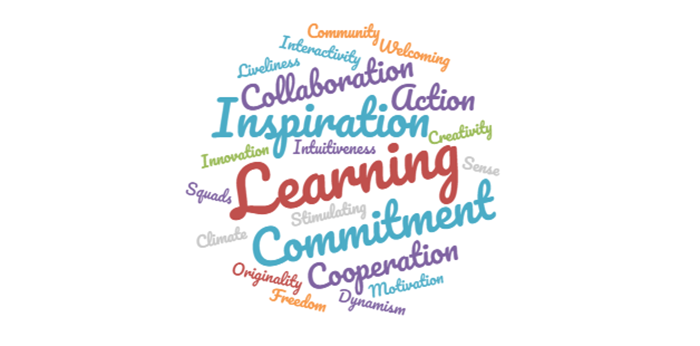
A word cloud of keywords that came out of our team brainstorming exercise discussing the ALC concept
Speaking of collaboration, this project could never have been developed without the support of the Academic Dean and Director General’s offices, Administrative affairs, the cooperation of the teachers and other key players in the Plant and Facilities department, the ICT Carrefour, Educational planning and Communications offices.
Our Royal ALC of Distinction: A pedagogical experimentation lab (C301)
In order to mark the beginning of a new era and dedicate the vocation of this space for active learning and pedagogical innovation, this classroom was designated as a laboratory for experimental teaching. The team paid close attention to all of the material and logistical details. The class is and will be equipped with more options than any other classroom in the college and distinguishes itself by its aesthetics and the quality of each of its carefully-chosen components.
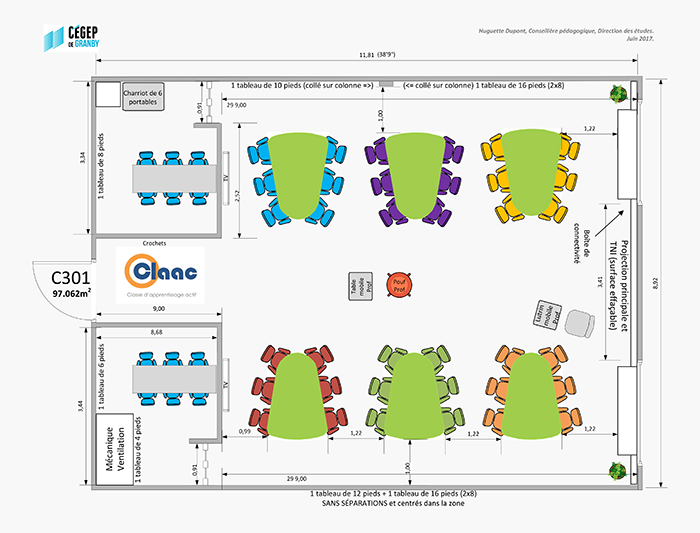
Layout of the C301 ALC
Here are the key features of the configuration:
- 6 tables with a special design inspired by Dawson College. This choice forces the planning of team-based activities and stabilizes the configuration of the space.
- The chairs – which are on wheels – are equipped with a basket where personal items can be stowed. Hooks allow students to hang their coats on the chairs. In an ALC, this promotes movement, and we need the space!
- The teacher has a mobile lectern, a pop-up table, a bistro chair and a footstool. The traditional teacher’s desk and lectern in front of the class has practically disappeared. Everything moves, allowing for the ultimate freedom and proximity to the students, in the centre of the classroom or elsewhere!
- 2 permanent cubicles provide the opportunity for a differentiated approach to supervising and supporting teams and allow students the choice of an isolated space for certain activities or to resolve conflictual situations.
- The colours are both low-key and stimulating at the same time to balance the stimuli.
- The lighting has been optimized through the judicious choice of blinds on the windows and a soft lighting system with a dimmer switch.
- Thematic signs in a variety of colours have been posted above the whiteboards and provide a distinctive character to the room that is our own. The signs use the same colours as the chairs in the room and help to facilitate classroom management and movement. The keywords on the signs that were chosen provide direction and inspiration and help us to share the objectives and values of our ALC.
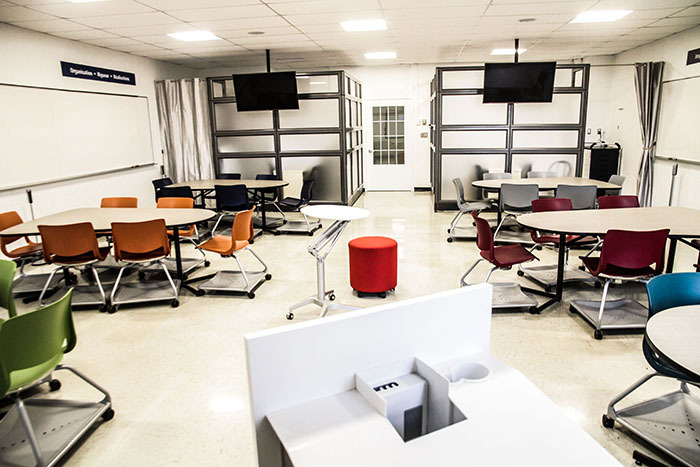
A view of the C301 ALC: The pedagogical experimentation laboratory
As for the tools and technological equipment, there is currently:
- A writing space on the whiteboard for each of the 6 teams that completely cover 2 walls (4 colours of dry-erase markers and a bunch of magnets inside a magnetic basket are available)
- An interactive projector that is equipped with wireless broadcast capabilities, rounded out with an Apple TV appliance, to facilitate projection from a variety of devices.
- 6 laptop computers in a cart that stays in this room
- 12 clickers
- 2 televisions allow for easier viewing of the projected content (students have their backs to the primary projector)
- A sufficient number of electrical outlets and mobile charging stations all around the room to facilitate recharging devices
For activities that require a large number of devices, we are wagering on the BYOD option. A cart of laptops or iPad tablets can also be borrowed from the library to ensure that a device is available for each student in an environment that is controlled and supported by the college.
The multi-purpose ALC adapted to a BYOD DCS/DEC and various needs (D130)
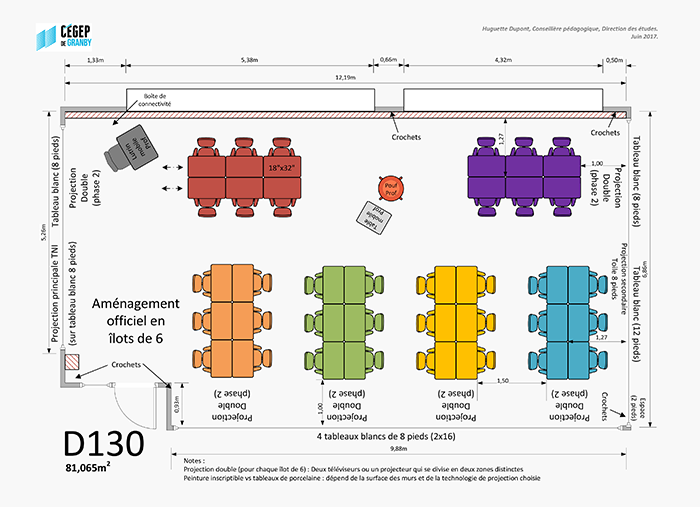
Layout of the D130 ALC room
We have ensured that there is a certain consistency between the ALC in C301 and D130 for the majority of the components in the space: same wireless interactive projector, same furniture for the teachers, same chairs for the students, coat hooks, whiteboards everywhere with dry-erase markers and magnets, colour panels, outlets and adequate amounts of mobile charging stations, etc.
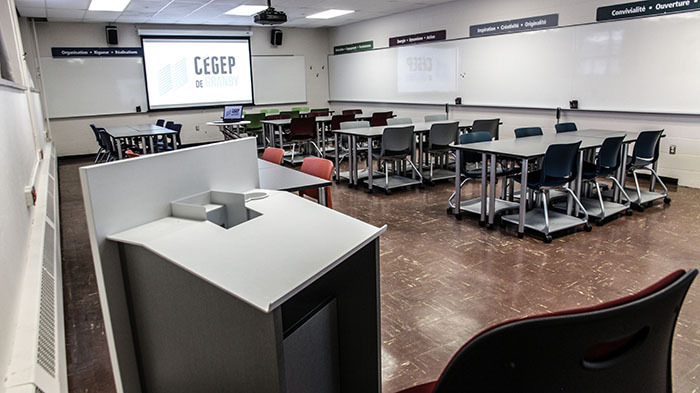
The D130 ALC – BYOD DCS/DEC in Tourism
Since this class is mainly used by a student clientele that is enrolled in a BYOD DCS/DEC (each student has their own laptop at all times) and it will be more-or-less the gathering point for Tourism students for the entire duration of their program, there are 2 aspects that are supremely important:
- The flexibility to adapt to a variety of pedagogical methods and contexts
- The necessity for electrical hookups
This is why we opted for small individual tables on wheels equipped with electrical outlets, permitting an infinite amount of layouts. This multi-purpose room also allows you to welcome other disciplines interested in active pedagogical methods.
Always moving forward, one small step at a time
As a Pedagogical counsellor and Répondante TIC (REPTIC), I am responsible for the logistical followup for projects and accompanying 2 teams of teachers. I don’t let them off the hook one bit, since it is very important to me to document each aspect of the projects and their evolution and support teachers in their pedagogical development.
Cégep de Granby Active Learning Classroom Photo Album
From the moment that the installation of the ALCs was confirmed, I suggested that the teachers continue our terrific collaboration by creating a community of practice where teachers can help each other and share their experience. Incidentally, we would like to establish links with other colleges so that we can share our experiences and learn from each other. Access to the ALC rooms is reserved for selected teachers and I work closely with the Educational planning department to establish the optimal conditions for their use, following the evolution of requests, ensuring that favourable conditions are in place to maximize the use of the room and pedagogical development.
In the end, we defined 3 active learning classroom models for future installations:
- ALC Classic: Minimal enhancements to promote collaboration and interaction with a minimal investment
- ALCExtra: Significant enhancements to promote mobility and heightened use of mobile technologies
- ALCRoyal: Optimal enhancements to support groups of teachers (experimental or research projects, BYOD DCS/DEC, etc.)
We are hoping to eventually improve the material that is provided to students, adding projection devices (projectors or televisions) to optimally exploit digital content and tools, and facilitate both interaction and student autonomy. Incidentally, we are still analysing wireless broadcast tools to offer even more mobility and functionalities to learners and teachers.
The buzz is palpable and teachers are already scrambling to have access to an ALC. It’s a nice problem to have!
Despite this enthusiasm, it seems essential to us to explore this new world one small step at a time using a cooperative approach, as much within our community as with other colleges in the network who are also exploring ALCs.
I can attest to the positive impact that these new classes have generated within our teachers. Their level of motivation, devotion to the team, diligent attendance of meetings, commitment to pedagogical planning and the creativity that they have demonstrated are all roughly proportional to the huge smile on their face since they started back to school in the fall. Happy teachers, happy students? We’ll find out during the next steps of our adventure.

